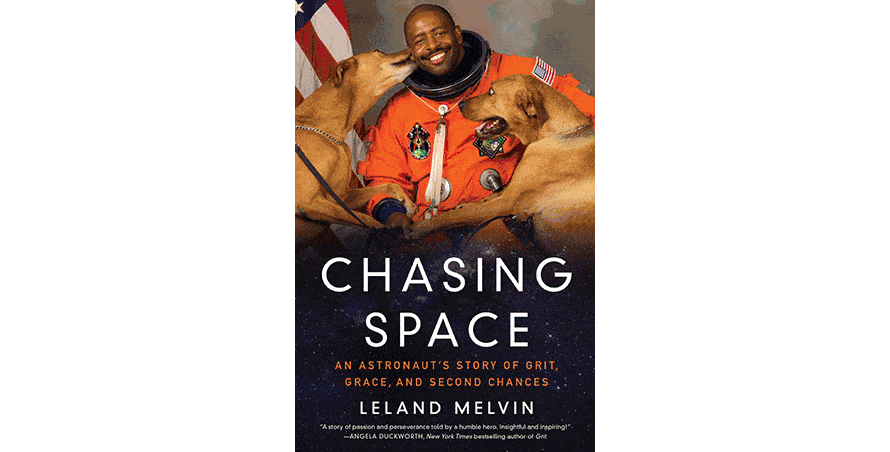Category: Nonfiction
Reviewed by: Clifford R. McMurray
Title: Chasing Space: An Astronaut’s Story of Grit, Grace, and Second Chances
Author: Leland Melvin
NSS Amazon link for this book
Format: Hardcover
Pages: 256
Publisher: Amistad
Date: May 23, 2017
Retail Price: $29.95
ISBN: 978-0062496720
Leland Melvin didn’t grow up wanting to be an astronaut. The model for his childhood aspirations was Arthur Ashe, the professional tennis player. There were no black astronauts he could look to as role models, growing up in Lynchburg, Virginia in the 1960s and ‘70s. But there were some professional athletes who looked more like him, whose career paths looked more attainable. Melvin discovered in high school that he had a gift for football, and won a scholarship to the University of Richmond. Before the possibility of being an astronaut ever entered his mind, it looked as though he was on track to become a different kind of star, in the NFL.
Melvin’s parents were both school teachers, and had high academic aspirations for their children. Their son was anything but a dumb jock. Before being drafted by the Detroit Lions, he earned a degree in chemistry. A hamstring injury at training camp ended his employment with the Lions, but a year later he was signed as a free agent by the Dallas Cowboys. In between, he’d started work on a Master of Science degree in Materials Science Engineering at the University of Virginia. He continued his studies even as he put in the punishing hours of pro football training. When another hamstring injury ended his football career for good, he was well on his way to a career as a professional engineer.
Space still wasn’t on Merlvin’s radar, but NASA was looking for more people who didn’t look like John Glenn or Gene Kranz by then. A very persistent NASA recruiter coaxed him to visit the Langley Research Center, where he took a look around and decided he preferred the kind of research he’d be doing there to a bigger paycheck in the corporate world. At Langley, he worked to develop optical sensors to monitor spacecraft health, and led the vehicle health monitoring team for the X-33. Still, he hadn’t been bitten by the astronaut bug. It was only when one of his colleagues at Langley, Charles Camarda, was accepted as an astronaut and after being encouraged to apply by no less an eminence than John Young, that he began to think it might be a path for him to follow as well.
Melvin was accepted on his first try, one of 25 out of 2,500 applicants to make the cut. His fellow classmate, Clayton Anderson, who’d been trying to get in for fifteen years, calls himself “the ordinary astronaut.” Melvin calls himself “the unexpected astronaut.” His future was looking up—literally. But on his first day of EVA training in the huge swimming pool at the Johnson Space Center used to simulate weightlessness, yet another unexpected injury almost took him out of the game. His spacesuit failed to equalize the pressure on his ears, and he lost his hearing. Medical experts were mystified as to exactly what had caused such a profound effect, and how to treat it.
It was a devastating setback, with no way to know if his hearing would recover. But again he displayed the dogged perseverance of his goals that had marked his life at every step. He simply continued his training, and waited. Make of it what you will, he did have reason to be hopeful. Less than a week before his accident, a minister friend of his family had delivered a prophecy that something unexpected would happen to him which no one understood, but that he would overcome it and fly in space. This would be his “testimony to share with the world.”
It was a slow recovery, but Melvin did eventually get cleared to fly in space—twice. He was never cleared for EVAs, so instead he worked the Shuttle’s robotic arm to help construct the International Space Station. He went on to become NASA’s associate administrator for its Office of Education, and after retirement from NASA he continued pursuit of his goal to inspire children as host of the television series Child Genius and as one of the judges on another TV show, BattleBots. “Paying forward” by nurturing the next generation of scientific and artistic talent continues to be a primary motivator for him.
Every astronaut is a person of extraordinary personal achievement. Some follow a path straight as an arrow from childhood dream to the launch pad. Melvin’s career was different. He moved from one setback to another, changing course and even goals as seemed best to him along the way, yet always giving his best and never allowing any blocked path to define his future. Being raised in a loving, solid family and having good mentors helped him to persevere, but the choices he made were his alone. The subtitle of this book mentions second chances; by my count, there were at least a half a dozen of those, any one of which might have sidelined a less determined individual. By the grace he was given, and the grit and grace he demonstrated, Leland Melvin didn’t let that happen.
© 2017 Clifford R. McMurray
Please use the NSS Amazon Link for all your book and other purchases. It helps NSS and does not cost you a cent! Bookmark this link for ALL your Amazon shopping!



















